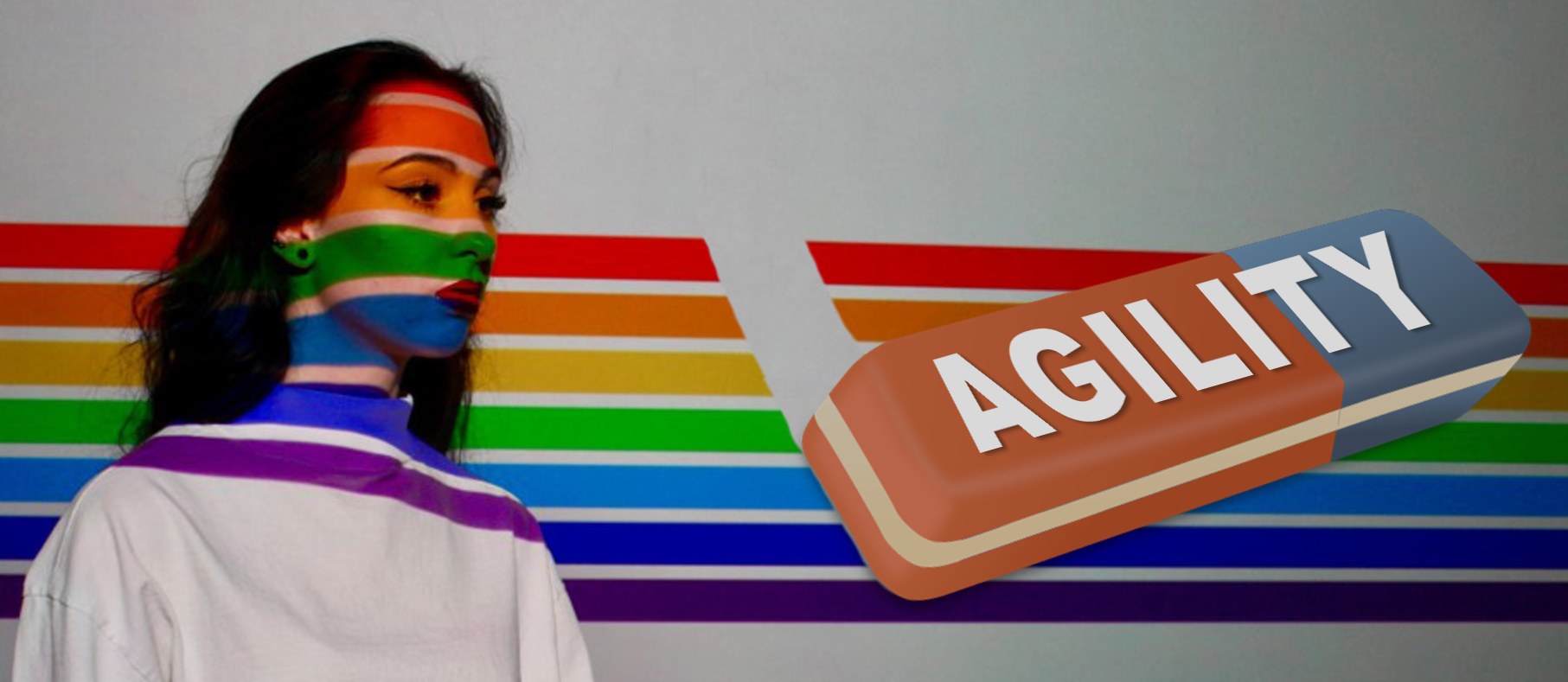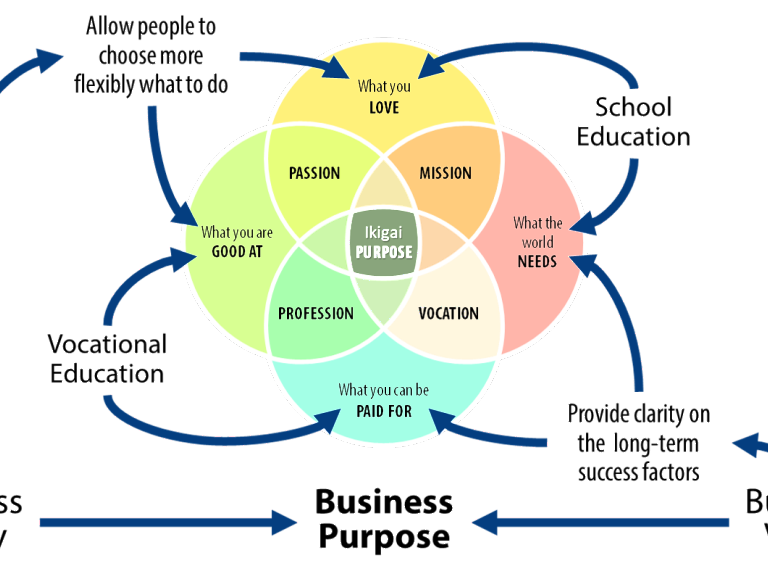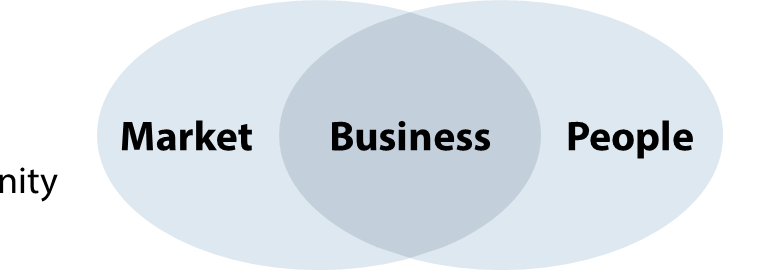Agile ways of working drive the business performance that diversity programs always promised. But agile practices do not promote diversity. Do diversity programs face obsolescence or will they be able to adapt?
The failure of diversity programs
The drive for higher levels of diversity in business has been ongoing for a while. There is general awareness and public debate about it and many companies have implemented diversity programs.
Companies launch diversity programs hoping for higher business performance. They hope that social diversity drives the diversity of skills and perspectives. They hope that hiring more women or gays drives better decisions, faster execution, higher customer value, and innovation. It may or may not. At best, diversity and performance just correlate. At worst, diversity programs fail.
A diverse workforce is not worth anything if it does not drive business performance. For this to happen reliably, we need to establish the causal link between diversity and performance.
Closing the gap between diversity and performance
To make diversity perform we need respect and inclusion on the side of the existing workforce.
Having a new colleague with another ethical background, a handicap, a difficult to understand accent, and who brings in new, potentially controversial viewpoints requires the existing team members to be tolerant and respectful: be welcoming, listen with an open mind, take time to understand. Respect is the first, passive step of making diversity work.
The next step is active inclusion. Existing team members and in particular the manager need to engage and integrate the new team member, ask for opinions, and assign tasks.
Traditional top-down approaches do not do this well. They often stop with measuring diversity: “Female staff contingent at 50%? Mission accomplished!”

Some programs go a little bit further by creating personal awareness that may facilitate respect. But moving to inclusion and business performance is often not part of the corporate programs and is left to others.
In an old hierarchical organization, this might have failed. Today, agile ways of working revolutionize teamwork. Is this a new chance for diversity?
Agile to the rescue?
Agile teams are built for performance and typically achieve 2-digit improvements in time-to-market, productivity, quality, and staff engagement.
They draw their power from cross-functionality promoting values like respect, openness and courage.
They are composed of professionals that are great with what they do. Team members are selected for their capabilities that help the team can achieve its objectives. Each team member respects the individual skills everybody has. There is a great sense of equality and no dedicated leader.
Agile practices require openness to create transparency about the team status. Everybody has complete information. Conflicts are not avoided but resolved with courage. Team members pro-actively ask for help and willingly offer help. It’s a very inclusive environment.
So regarding the values of respect and inclusion, we can indeed assume that agile ways of working are potentially better geared to unleash the business value of diversity.
But does this mean that agile teams are actively seeking diversity? Are they truly more likely to hire ethnic minorities, gays, the old, or physically challenged individuals? I fear not so.
Agile does not require diversity
Agile teams are empowered and enabled to organize themselves to best serve their customers and continuously deliver value. That is their sole purpose.
Cross-functionality is needed for this. A team needs to have all the skills so it can do its job. It requires a certain diversity of skills. But in which form the skills come to the team, as a senior, female, gay, Muslim or black is not mandated.
Agile draws its power from skills diversity, not social diversity.
It may even discourage social diversity as additional, not needed diversity, may slow down the creation of trust between its members which is critical to becoming a high-performance team.

Every agile framework names values it sees as fundamental for success. But agile frameworks including Scrum, XP, SAFe and Spotify do not list inclusion or diversity. Why? Because it is not required to run agile teams successfully. On the contrary.
Agile practices are not for everybody. The constant pressure on being open and transparent, daily stand-ups that check-up on you, the constant learning and continuous change requires a specific mindset that does not come naturally for many. The risk of agile burn-out and dropping-out is high.
The worst I ever came across was a newly formed team that was composed by top-down delegation without first checking on the willingness of individuals to participate. In this team, a whopping 50% dropped out. Agile transformations like the ones of ING and Zappos point to similar figures.
For those who stay, agile practices may prove challenging. Huge open space PI planning events are hard to follow for the hearing impaired, huge walls plastered with post-its are hard to read for people with vision impairments and impossible to reach for people in wheelchairs.
A business that adopts agile ways of working may have to adjust its hiring requirements to screen out a large part of the average workforce.
That is very much the opposite of being diverse and inclusive.
The ultimate dilemma: is diversity still needed?
Agile approaches deliver the performance that diversity programs promised. But agile approaches are not built for diversity. Is diversity dead?
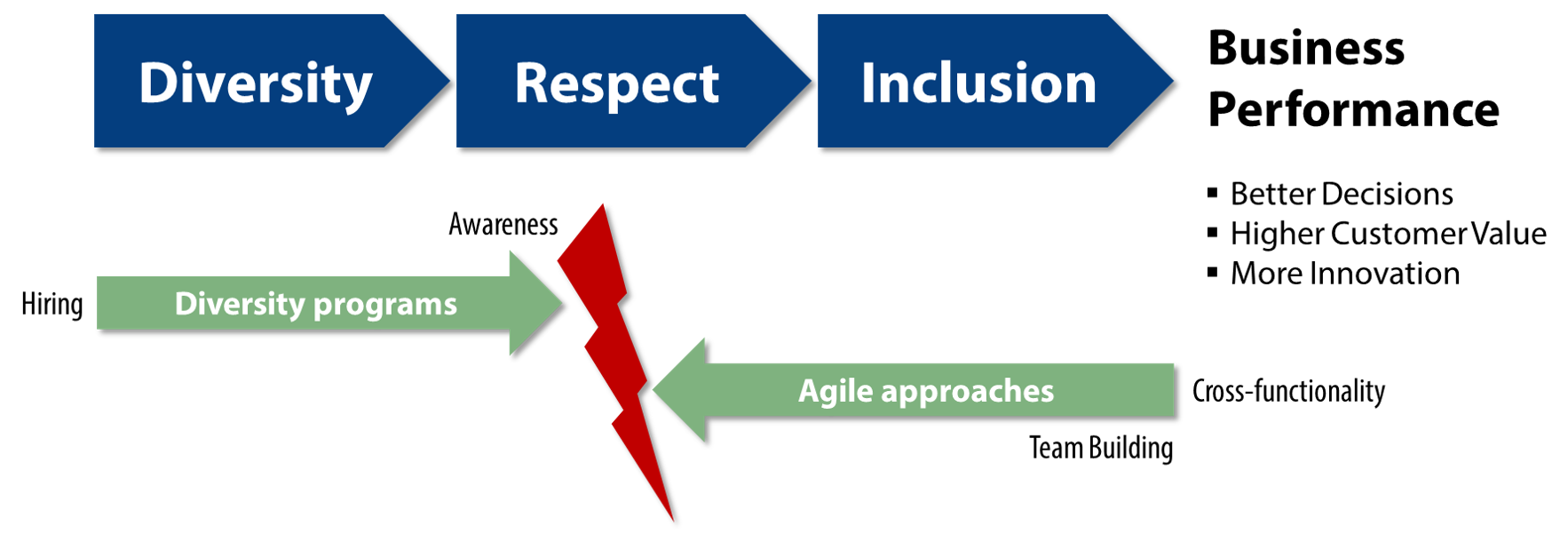
If your business is just about making a profit you may be tempted to say “Yes”. Agile ways of working give you the performance you always wanted and those diversity programs are just overhead! So why bother?
This is a very dated view in times where the days of profit-only businesses are numbered.
In a world looking for real CSR and purpose, we cannot accept agile businesses turning into exclusive, homogenous organizations where only a certain stereotype finds employment.
Our businesses need to become more representative of our societies, not the other way round.
From a social perspective, we must continue with our objectives to achieve social diversity. Now, more than ever.
The reset of diversity programs
Inclusive societies make the world a better place. They require inclusive businesses. We need to continue building them. For this, our approach to diversity has to change. I see two different approaches: bottom-up and purposeful diversity.
A new way of working bottom-up
The days of top-down, hiring-based corporate diversity programs seem to be over. But this does not mean that an organization cannot continue to put a focus on diversity.
It starts with the agile teams themselves. They are self-organizing, free to choose how they work, and who they work with. Agile teams are free to welcome a person with a diverse background in their team. But why would they do this?
Agile teams decentralize decision-making that benefits from local, customer-focused knowledge. This knowledge may have to come from the outside in the form of socially diverse hires from the local communities. For example, a US firm operating in Malaysia may need to hire more Muslims to engage its local customers better.
Locally embedded agile ways of working may lead organizations to become more diverse bottom-up and deeper connected with their local communities.
Another factor that drives agile teams to be more diverse is the increasing adoption of agile ways of working by the business.
Agile ways of working have reached up to 77% of the business units outside of IT including back office, sales and marketing.
These areas require different approaches and diversified agile practices to make them inclusive to people from those areas.
Practitioners developing agile practices for new business areas must consider diversity and inclusion. This will also prevent that agile teams suffer staff shortages.
Agile ways of working traditionally favour face-to-face meetings. The Covid-19 crisis accelerated the willingness of the agile community to experiment with new remote practices which are more inclusive by nature.
This turns the entire approach to achieving diversity on the head. It does not depend any more on top-down corporate programs but on individual team members’ choices, mindset, behaviours, and practices.
Over time, we will see elitist agile ways of working evolve into more inclusive and diverse new ways of working that are open to more if not all members of staff and society.
A new way of governance with purposeful diversity
To make diversity a reality bottom-up agile teams will require guidance and support. Instead of running top-down corporate programs, HR staff will have to engage hands-on and directly with the teams acting as diversity coaches.
Going hands-on with diversity coaching is one potential direction for the evolution of corporate diversity programs. Another direction is to put them in a larger context.
It may no longer be an intrinsic aim for an organization to achieve diversity for the benefit of internal performance, but it needs to be a social aim. Having a diverse and inclusive society that spans all sectors is desirable and change is coming.
Diversity programs will shift their focus from internal to societal impact as bolted-on CSR programs are exposed, purpose-driven companies emerge, and corporations become more human.
The benefits are clear. Pursuing diversity with purpose will allow organizations to attract more top talent, investors, and subsidies. Businesses that accept social responsibility, become socially diverse, and inclusive will gain competitive advantages.
The learnings from corporate diversity programs will contribute to the emergence of more comprehensive corporate governance programs centred on CSR and purpose.
Putting it all together
If we combine our learnings from corporate diversity programs and the agile movement to devise new ways of governing and working we will see the emergence of a new type of organization that is embedded deeper with its local communities and delivers more value to society.
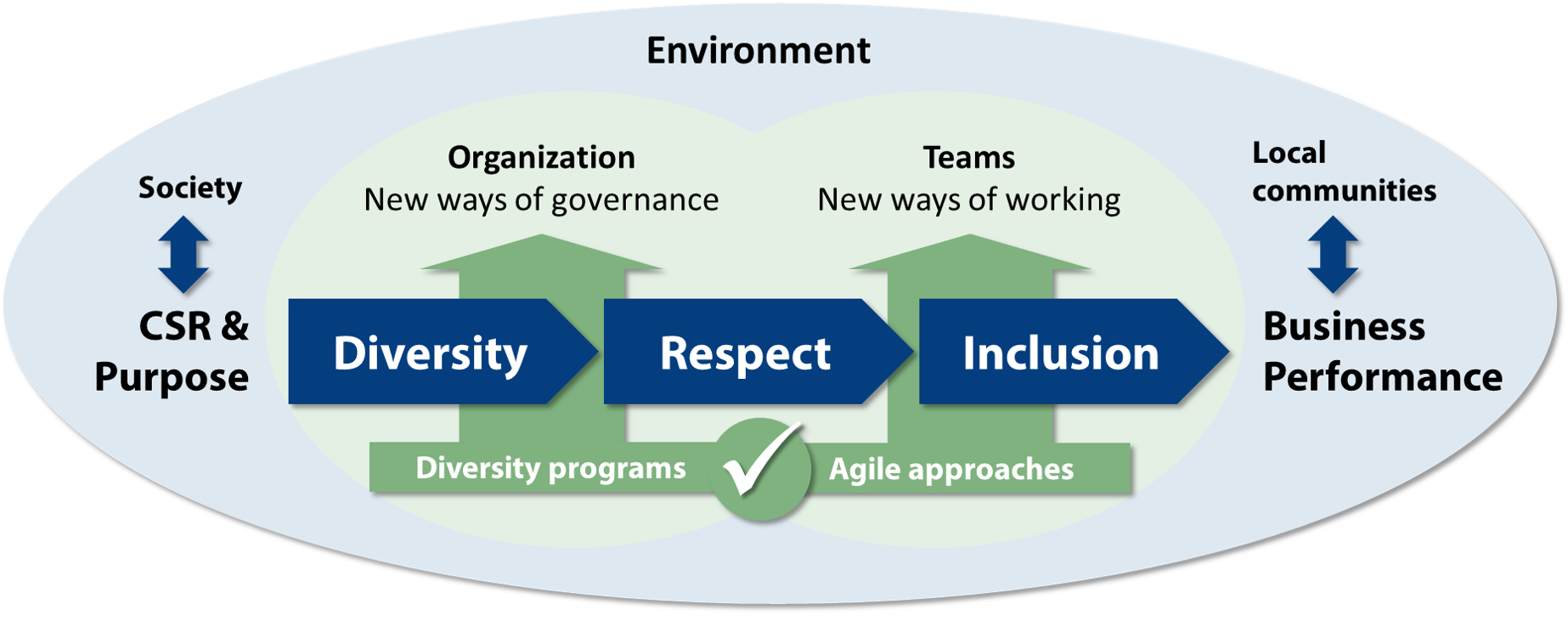
An organisation that achieves such a grand connection between its long-term purpose and bottom-line day-to-day execution will make the world a little bit better. To achieve this, organizations and teams need to operationalize and live the link between diversity and inclusion.
Conclusion
Despite their current discriminatory tendencies, agile practices have a huge potential for increasing social diversity. Realizing this potential is up to you.
If you are passionate about agile and believe that it makes the world a better place, you need to constantly challenge yourself to keep social diversity and inclusion on the agenda in your team.
As agilists, we need to think about how we evolve our practices to be more barrier-free. Even if it means to digress from seemingly absolute agile wisdom.
Agile needs to embrace social diversity to continue to prosper as it matures, moves out of software development, and conquers the business world.
The topic is gaining traction within the agile community. The Agile People Manifesto states that “Agile People actively embrace diversity and inclusion to create communities where people feel safe and truly belong”. The Business Agility Institute has recently commissioned research about the topic.
Calls to action
We don’t require programs or manifestos to get started. It is up to all of us now.
Agilists: make a personal effort to go beyond cross-functionality to consider diversity when choosing a new team member. Always be respectful and inclusive. Practice mindfulness as needed.
Agile teams: Discuss how you can jointly make diversity and inclusion a reality. Add related impediments to your backlog and involve HR.
Leaders: Pay attention to team issues and promote diversity and inclusion.
Executives: Do not stop your diversity programs but evolve and integrate them with other CSR and purpose initiatives for greater impact.
Everybody: challenge your existing and choose your new employers and business partners based on their demonstrated willingness and actions to promote diversity and inclusion.
I would like to thank Mark Green from Agile Inclusion Revolution for his inspiration and guidance.
Thomas Martin is a consultant, trainer, coach and speaker for agility, foresight, and strategy. He is the creator of the MyBusinessAgility framework for success in VUCA times and the CEO of Forward Intelligence Group.

